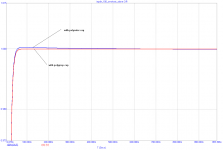Don't worry PMA,
I don't. I assume that many are happy with 64kbit/s mp3 and would find it indistinguishable from master tape or 192kHz/24bit in a well controlled, scientific A-B-X test 😉
If you would want Bob Pease's article you should Google: 'The best of Bob Pease'. It should be there. I find the article useful.
The problem we had with the polyester cap was similar (shape) to the attached simulation, but settling time was longer, in us. The 'overcompensation' or 'undercompensation" was not the case, it was impossible to tune it by R,C values (R//C-R//C) divider. It was fixed with polypropylene caps.
Attachments
The problem we had with the polyester cap was similar (shape) to the attached simulation, but settling time was longer, in us. The 'overcompensation' or 'undercompensation" was not the case, it was impossible to tune it by R,C values (R//C-R//C) divider. It was fixed with polypropylene caps.
That would show up nicely on our bridge null test. An historical point, a professor from SUNY sent a very nasty letter to Ed Dell and in essence he denied the existance of any effect rather that deal with the issue. I think a lot of folks get to this point. I was in the middle, there is an effect and I don't see anything going on that is audible except in the grossest context. The talk of "memory" and "echo" was unfortunate and inaccurate, and I did not want to support it.
The same issue arrises with cap distortion. Folks measure distortion with considerable AC on the cap and extrapolate that to performance where there is no AC on the cap (coupling well past 3dB, bypass).
Good points about the AC voltage across the cap Scott. You do need to keep it very low to avoid the distortion.
That would show up nicely on our bridge null test.
Probably yes, as the issue we had was more related to frequency dependence of capacitance of the polyester capacitor. For the R//C-R//C voltage divider the DA is not that much an issue (parallel resistor). But is a GREAT issue in the (R-C)-(R-C) divider (series damped capacitive divider). I was building these dividers for HV impulse voltage measurement, and I have been aware of the DA problem since the beginning of the 80-ties.
Regards,
Variation of capacitance with frequency for several cap types. MKN is polyethylene, and this makes biggest troubles regarding step response. It is impossible to make proper step response compensation with this cap, as the response is both over and under compensated.
Attachments
I don't. I assume that many are happy with 64kbit/s mp3 and would find it indistinguishable from master tape or 192kHz/24bit in a well controlled, scientific A-B-X test 😉
Nonsense. Or sloganeering, your choice.
MKN is polyethylene
No, it's not. MKN is generally PEN, a type of polyester. Polyethylene is rarely used as a dielectric (despite superb dielectric properties) because of its low melting point.
Variation of capacitance with frequency for several cap types. MKN is polyethylene, and this makes biggest troubles regarding step response. It is impossible to make proper step response compensation with this cap, as the response is both over and under compensated.
Is that plot capacitance or imaginary part of impedance?
No, it's not. MKN is generally PEN, a type of polyester. Polyethylene is rarely used as a dielectric (despite superb dielectric properties) because of its low melting point.
EPCOS data sheet says PEN = polyethelene napthalate
Is that plot capacitance or imaginary part of impedance?
Axis shows delta C/C. So effective capacitance varies by 8% at 1 MHz.
Is that plot capacitance or imaginary part of impedance?
deltaC/C (cap. dev./cap)
Axis shows delta C/C. So effective capacitance varies by 8% at 1 MHz.
Yes, and this makes pretty bad step response.
We had a trick, in High Voltage dividers. For 1 : 200 divider, make it from a chain of 200 equivalent cells (R//C or R//R-C). Then the parasites and non linearities divide at 1 : 200 as well.
No, it's not. MKN is generally PEN, a type of polyester. Polyethylene is rarely used as a dielectric (despite superb dielectric properties) because of its low melting point.
You are wrong. MKN is polyethylene naphthalate. MKT is polyethylene terephtalate = polyester. I have already told you that you know almost everything, but just almost.
deltaC/C (cap. dev./cap)
I will have to research mechanisms for C rising with frequency.
The Siemens/EPCOS doc is at
http://www.epcos.com/web/generator/...__en.pdf;/PDF_GeneralTechnicalInformation.pdf
(page 13)
http://www.epcos.com/web/generator/...__en.pdf;/PDF_GeneralTechnicalInformation.pdf
(page 13)
You are wrong. MKN is polyethylene naphthalate. MKT is polyethylene terephtalate = polyester. I have already told you that you know almost everything, but just almost.
Polymers I know reasonably well. Polyethylene terephthalate (PET) is a polyester. Polyethylene naphthalate (PEN) is a polyester as well. There are lots of polyesters- anything with a structure of -R1-CO-O-R2- is a polyester. PEN and PET have different Rs, but the same polyester structure.
Polyethylene is a polyolefin, a completely different polymer family. No carbonyls, no oxygens, no aryls, just (CH2)x.
- Status
- Not open for further replies.
- Home
- Member Areas
- The Lounge
- John Curl's Blowtorch preamplifier part II

